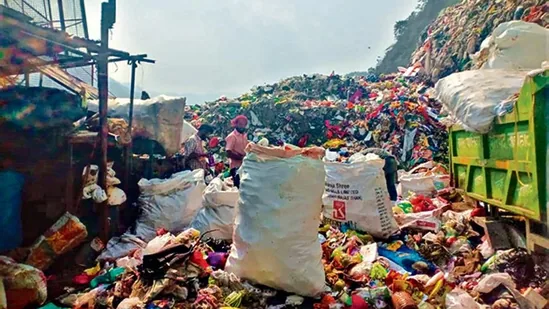
When faith turns careless, even the Ganga cannot wash away our sins of plastic.
Faith Meets Filth: How the Sacred Rivers of Devbhoomi Are Turning into Plastic Dumpyards
Uttarakhand, celebrated as Devbhoomi—the land of the gods—is now fighting a man-made disaster. What should have been the sparkling waters of the Ganga and its tributaries are slowly becoming plastic highways. As per the Uttarakhand Pollution Control Board, the state produces close to 150,000 tons of plastic waste every year, of which over 3,000 tons directly end up in rivers like the Bhagirathi, Alaknanda, and Mandakini.
Its single-day collection of almost 11 tons of plastic waste is recorded during the peak religious period, like the Kanwar Yatra and Char Dham pilgrimage. Disposable plates, plastic-wrapped offerings, empty bottles, and chip or snack packets pour into the same rivers that are held sacred by the pilgrims.
In short, devotion is being drowned by negligence.
Why This Issue Exploded in Headlines Now: The Viral Video That Shook Uttarakhand’s Image
This tale attracted national attention once more in August 2025, when a viral clip unveiled enormous quantities of plastic debris in the Ganga tributaries along Rishikesh. The issue was not new for many, but the pictorial evidence inflamed fury. The timing was apt: post-monsoon months witness an increase in tourism and pilgrim traffic, putting a strain on the already weak waste management system of riverbank towns.
Digging Deeper into the Causes: How Tourism, Rituals, and Weak Enforcement Fuel Plastic Pollution
The reasons behind this crisis are not one but many. Pilgrim numbers have multiplied, but waste disposal systems haven’t kept pace. Weak enforcement, cultural habits, and short-term tourism revenue priorities have all added fuel to the fire.
Major causes are:
- Religious Tourism Pressure: More than 3.5 crore pilgrims come to Uttarakhand every year, many of whom depend on single-use plastics.
- Poor Waste Management Systems: A mere 60% of the state’s waste is collected, and most of it gets unsegregated.
- Failure of Enforcement: Despite prohibitions under the Plastic Waste Management Rules, 2016 (amended 2022), enforcement is weak.
- Cultural and Ritual Habits: Plastic-covered offerings, plates, and bottles disposed of at ghats add in a big way to the mess.
The Domino Effect: How Pollution in Haridwar Flows Downstream into India’s Heartland
The tragedy is not limited to Uttarakhand. The Ganga river system supports nearly 40% of India’s population, which means the plastic tossed in Haridwar or Rishikesh today may be contaminating water in Kanpur, Patna, and even Kolkata tomorrow.
Scientific studies by CSIR have shown that 85% of samples collected from the Ganga basin contain microplastics, which not only harm aquatic life but also seep into drinking water. Fish ingesting plastic particles disrupt the food chain, directly affecting farmers and fisherfolk. The danger is not abstract—microplastics have already been linked to kidney, liver, and hormone-related diseases in humans.
Courts and Government on Alert: What the NGT and Namami Gange Projects Have Warned About
Even India’s judiciary has had to intervene. The National Green Tribunal (NGT), in a 2023 directive, strongly criticized the state governments for failing to control river pollution, warning that “the Ganga must not be reduced to a drain.”
On the policy side, the Namami Gange Mission (NMCG) has invested over ₹20,000 crore since 2015 into river-cleaning programs, sewage treatment plants, and awareness campaigns. Yet, without proper local waste collection systems, plastics remain a stubborn enemy.
What Needs to Be Done Urgently: A Collective Battle for Clean Rivers
The battle against plastic pollution in Uttarakhand’s rivers cannot be won by the government alone. It needs the combined efforts of citizens, pilgrims, and local communities.
Immediate steps include:
- Government action: Stricter enforcement of plastic bans, installation of recycling kiosks and reverse vending machines, and incentives for eco-friendly businesses.
- Citizen responsibility: Carry reusable bottles and cloth bags, avoid throwing offerings in plastic, and participate in community clean-up drives.
- Local community measures: Spot fines for littering (₹500 or higher), proper segregation at ward levels, and active monitoring of ghats.
Will Devbhoomi Remain the Land of Gods or Turn into India’s Plastic Graveyard?
The rivers of Uttarakhand are not mere water streams; they are spiritual icons, ecological lifelines, and economic pillars. Permitting them to become dumping grounds is not merely environmental neglect—it is cultural betrayal.
The crisis is at hand, yet the remedy is within reach. If pilgrims, tourists, and residents accept small but persistent shifts—such as stowing steel bottles, reusing cloth bags, and declining plastic-wrapped offerings—Devbhoomi can still be preserved. Otherwise, the same Ganga that bore faith might soon bear only plastic.
FOR MORE BLOGS – beyondthepunchlines.com

 Add to favorites
Add to favorites





